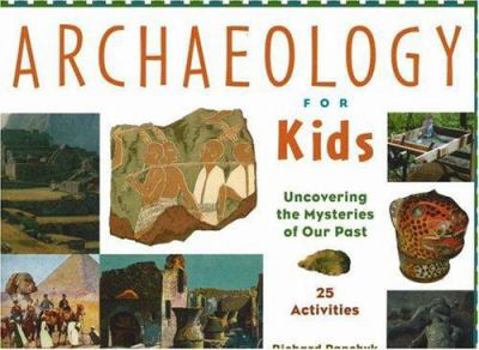Archaeology for Kids: Uncovering the Mysteries of Our Past, 25 Activities Volume 13
(Part of the For Kids Series)
Select Format
Select Condition 
Book Overview
This activity book features 25 projects such as making a surface survey of a site, building a screen for sifting dirt and debris at a dig, tracking soil age by color, and counting tree rings to date a... This description may be from another edition of this product.
Format:Paperback
Language:English
ISBN:1556523955
ISBN13:9781556523953
Release Date:October 2001
Publisher:Chicago Review Press
Length:160 Pages
Weight:1.22 lbs.
Dimensions:0.4" x 10.9" x 8.5"
Age Range:10 to 13 years
Grade Range:Grades 5 to 8
Customer Reviews
2 ratings
Archaeology can be fun
Published by Thriftbooks.com User , 17 years ago
I purchased this for our 12 year old daughter along with several other books on Archaeology for her use during our "Independent Activities Period" over the summer. I read through it quickly and found it generally well written and interesting. I would have liked more text on how archaeologists do their work, more details on the discovery processes, and more describing how a small fragment is used to reconstruct the original. My impressions is that the book is written more for the High School crowd. She is reading about a chapter a day and asks good questions over the material. Overall, I'm pleased with the purchase.
A great set of practical activities for teaching students about archaeology
Published by Thriftbooks.com User , 18 years ago
"Archeology for Kids: Uncovering the Mysteries of Our Past" is intended to foster a curiosity about this particular science in budding archeologists. Richard Panchyk begins with a Time Line that starts in 65 million B.C. when the last dinosaurs died out and ends in 1997 when a new Egyptian burial ground was found, containing almost 10,000 mummies. Actually it is not the end of the dinosaurs but the first Ramapithecus, Australopithecus and other human ancestors that matter more because this time focus on not only key historic events such as the end of Roman Empire and the American Civil War, but key events in the field of archeology, such as when Schliemann began searching for the city of Troy and the Australopithecus remains of "Lucy" being found. This will give teachers an idea of where (and when) this book can be helpful in teaching about the past to today's students. Then there are the more than 25 activities that will help those young students understand archeology and the ancient cultures that have been uncovered. Panchyk beings with an Introduction addressing the question, What Is Archaeology? The short answer is that archeology is the best tool we have for solving the mysteries of ancient lives. The goal of this book is to teach young students about how archaeologists work and what they have discovered (so far) about the past. That is why the first chapter outlines the eight basic steps of archeology, which begins with the question "What do you want to find?" and ends with the preservation of what you find. In between we learn that having money is just as important as engaging in excavation. Once you know the basics of the science, then you can look at six particular periods and places of ancient history that have been studied in this manner. Chapter 2 is devoted to The First People and has activities for making molds of footprints and a spark in the dark, measuring brain capacity, and how to create stone tools. You can see that these are real world activities. There is also a section that explains why most archaeological sites are underground even if ancient people did not live there. Chapter 3, The Ice Age and the New Stone Age, includes an experiment to see what sort of items are preserved well in ice, building a Paleolithic fireplace, making cave art and a microlith tool, experimenting with agriculture, and an exercise to see what we can learn from finding animal bones about diet and lifestyle. Chapter 4, The First Civilizations, focuses on Sumeria, Babylon and Egypt, and has a pair of interesting sidebars, one that lists some of the common remains of civilizations that can be used to identify them and another concerning independent invention of things like makeup and writing. This chapter includes a seriation game (putting things in date order), a problem involving what happens when different people have different money and want to buy things from each other, an exercise involving pottery classification, and how to






